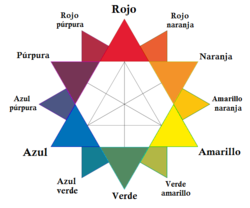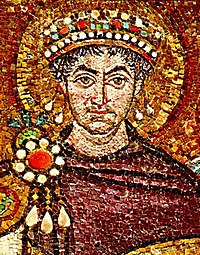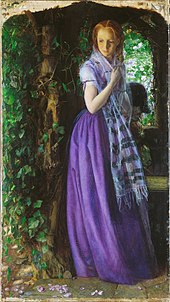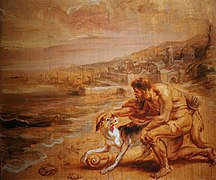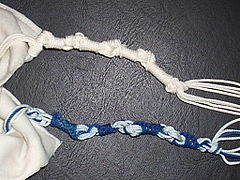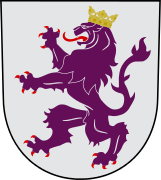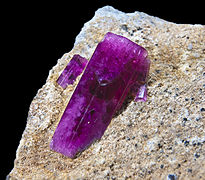Purple
- This article deals with purple.
Purple is the color or colorations found by mixing red and blue, or more specifically it is a dark magenta color that falls between violet and crimson. The term comes from the marine snails also called purple (Stramonita haemastoma, Nucella lapillus), and this is also the name given to the color produced by the oxidation of the ink of these snails, (ink highly appreciated since ancient times) and the fabrics dyed with it.
It is not a standardized color, that is, its tonality can be variable.
Popularly, names such as purple, violet, lilac, mauve, magenta or purple are used as synonyms. However, these denominations have different etymologies, and although they are also colorations between red and blue, they have generally developed their own specific meaning.
Definition and scope
Etymology
The word purple derives from the Latin purpŭra, 'mollusk that produces a purplish dye, dye obtained from the mollusk, cloth or garment dyed with that dye', which comes from from the Ionian Greek πορφύρη (πορφύρα, porphýrā, in Koine), with the same meanings. The Greek term, in turn, originates from a Semitic word that designated the sea snail with which it was made the purple dye.
It is believed that the names of the ancient regions of Canaan and Phoenicia may be cognate terms for the color purple. Canaan could derive from the Akkadian word kinahhu ('purple red'), while Phoenicia would come from the Greek φοινός (foinós, 'dark red') or φοῖνιξ ( foinix, 'purple, scarlet').
The first appearance of the term «purpura» in the Spanish language dates from the year 1220.
Differences between purple and similar colors
Samples of colors standardized in color catalogs are given below. The terminology used in this article corresponds to these colors.
405-460 nm
#382983
395 to 405 nm
#4C2882
380 to 395 nm
#612682
(not spectral)
#7D2181
(not spectral)
#A11480
(not spectral)
#E40078
(not spectral)
#E30049
Between purple and violet
- As has been said, in a color diagram of at least twenty-four shades, the purple, in a broad sense, ranges from the purple red to the blue purple; the violet is then found in the range of purple blue.
- Unlike purple, the violet is a spectral color: a light with a dominant wavelength of between 420 and 380 nm is violet.
- An interesting psychophysical quality that serves to differentiate the purple of the violet is that the appearance of the violet varies with the intensity of light or luminance. The violet, as the intensity of the light increases, appears to acquire a more bluish nuance, as a result of the so-called Bezold-Brücke phenomenon, where the wavelengths below 500 nm are stained with blue, while the superiors turn to yellow. Purple, being a mixture of wavelengths, does not suffer this phenomenon.[chuckles]required]
Between purple and purple
Being a bluish purple, purple is technically purple. The difference between purple and purple is semantic, since the adjective color "purple" originates from the description of the pigmentation of blackberries, fruits of the tree called mulberry (Morus nigra).
Historical, cultural and linguistic variants
"Purple" Dyes and Textiles
The word "purple" refers to the coloration of certain fabric dyes, the color they produce, and the fabrics dyed with them, not the name of a particular color. These dyes were made from the secretions of various species of sea snails, and in ancient times were produced in different regions of the globe, although Western language and usage were influenced in particular by the ancient purple-dyeing industry of the Mediterranean region..
Because dyes were difficult to obtain, purple-dyed cloth was extremely expensive and its use was restricted to those who could afford it. Eventually the purple-dyed garments acquired a symbolic value, denoting nobility: in Imperial Roman times, for example, only the emperor was allowed to wear them.
Vitruvius, in the 1st century B.C. C., reports that the coloration of the purple dye varied between bluish and reddish, and attributes this variation to the place of collection of the molluscs with which it was made; however, today it is considered that the variation could be due to the use of different species of snails (each of which produces a somewhat different color), to the mixture of the dyes with the purpose of obtaining color variants, or to other peculiarities of the dyeing procedure.
During the Middle Ages, the technique for making the classic purple dye was lost, and this was replaced by the carmine red obtained from kermes, a species of cochineal. The onerous finery worn by emperors, nobles, and high officials thus changed color, but not name. Even today, one of the meanings of "purple" is "garment, of this color or red, which is part of the characteristic costume of emperors, kings, cardinals, etc."
According to Philip Ball, throughout Antiquity and the Middle Ages the Latin term purpure could denote a color ranging from violet to dark red.
Purple as a “rich” color or sumptuous fabric
Michel Pastoureau, in his book A Symbolic History of the Western Middle Ages, warns historians about translations of color terms in ancient texts:
Where the Hebrew says “rich”, Latin often translates through purpureus and the vulgar tongues for "purpura".
On the other hand, according to the ancient Anglo-Saxon art historian Charles Reginald Dodwell, the Latin term purple referred to a variety of thick, gaudy, and expensive silk cloth of more than one color. Dodwell considered that this fabric could have been similar to taffeta, with the warp threads of one color and the weft threads of another, so that with movement, as light fell on its folds, it changed color. This type of cloth, despite its name, could be of any color: textual historical sources studied by Dodwell mentioned purple cloth that was predominantly red, white, black, and green.
Purple in the traditional color model
Since the trichromatic color pattern was discovered in the 17th century, purple has been considered the secondary color that It can be produced by mixing the red and blue primaries. Such is the case of the coloring system of D'Aguilon, who in 1613 wrote the term "purpureus" in Latin. A treatise on painting in French from 1708 is more placing purple (pourpre) between violet and crimson red. ) between purple-blue and purple-red; and in Wilhelm von Bezold's German color theory (1874), purple (purpur) is between red and violet.
In other traditional models, violet appears as a secondary color instead of purple. For this reason it is considered, for example, that violet red is equivalent to purple red and, for English speakers, the term purple is synonymous with violaceous or violet.
Linguistic peculiarities
The definition of the color purple can vary depending on the language. Not only translators of ancient texts must exercise prudence, but also those who interpret and translate living languages.
Purple in German
- In German language, the purple color (purpur) is defined at the popular level as an intense red, something purpureo, comparable to the carmine of pictorial use. But it can extend from the carmine to the violet.
Purple in French
- In French, purplepourpre) is an intense dark red or violet red.
| Pourpre | |
|---|---|
| HTML | #9E0E40 |
| RGB | (158, 14, 64) |
| HSV | (339°, 91 %, 62 %) |
| Reference |
Purple in Italian
- In Italian, purpleporpora) is again a semi dark and intense red. You can go from the carmine to the violet red.
| Porpora | |
|---|---|
| HTML | #B21B1C |
| CMYK | (30, 100, 100, 0) |
| RGB | (178, 27, 28) |
| HSV | (0°, 85 %, 70 %) |
| Reference |
Purple in English
- In English, the purple denomination (purple) encompasses a wide set of colorings ranging from red purple to violet, and includes the latter.
| Purple | Purple | Purple | |
|---|---|---|---|
| HTML | #870074 | #602F6B | #604E97 |
| RGB | (135, 0, 116) | (96, 47, 107) | (96, 78, 151) |
| HSV | (308°, 100%, 53 %) | (289°, 56 %, 42 %) | (255°, 48 %, 59 %) |
| Reference |
Purple in Portuguese
- In Portuguese, Roxo, term cognated with the Spanish «red», means, however, «pura». It should be mentioned that in Portuguese there is also the term purple to designate this color, working as synonym Roxo.
Purple in Spanish
- According to the Rae dictionary, in its meaning 9, One color said: Dark red that shoots violet, but in his first insights, he does not refer to a color, but to the dye: 1. f. Molusco marine gasterópodo, whose shell, twisted and rough, has a wide mouth or opening or with a skeleton at the base, and which secretes in very small quantity a yellow ink, which at the contact of the air takes green color, which then changes in red more or less dark, in violet red or violet. 2.f. Very expensive dye that the ancients prepared with the ink of various purple species or other similar molluscs. From what is deduced that the purple word refers in general to the dye in itself, and not to a certain color, since the dye can give a range of them between the violet and the scarlet.
Purple in Japanese
- In Japanese language, purple is called murasaki (.) and in its standard form is a reddish purple. By the end of the 19th century the name was introduced in Japan paapuru for purple, derived from English purple. Below is the standard Japanese purple.
| Murasaki | |
|---|---|
| HTML | #AC5CB5 |
| Munsell | 7.5P 5/12 |
| RGB | (172, 92, 181) |
| HSV | (294°, 49 %, 71 %) |
| References |
Spectral and extra-spectral color
Purple has been considered a non-spectral color. However, if you see its RGB chromatic composition, you will notice that the value of blue is usually equivalent to that of red, or it can also be a little higher or lower depending on the coloration analyzed. When the red is greater, as in reddish purple, it will be a non-spectral color; but if the blue is greater, as in bluish purple, then it is spectral, because it is in the range farthest from violet light. Finally, if blue and red have very close values, as in standard purple or magenta, it reaches a wavelength at the same end of the visible spectrum with 380 nm, practically imperceptible to the eye and is therefore considered non-spectral.
Spectral Purple
It forms the outer part of the spectrum of spectral violet. Here some examples:
| Name | Sample | Cod. Hex. | RGB | HSV | ||||
|---|---|---|---|---|---|---|---|---|
| Electric Purple | #BF00FF | 191 | 0 | 255 | 285° | 100% | 100% | |
| Electric Purple orchid alive | #CC00FF | 204 | 0 | 255 | 288° | 100% | 100% | |
| Psychodelic or flox | #DF00FF | 223 | 0 | 255 | 292.5° | 100% | 100% | |
These examples span roughly a wavelength between 388 and 397nm, making them part of the extreme region of the visible spectrum.
Non-Spectral Purple
The colors purple and red-purple light cannot be generated by a single wavelength of light, so they do not exist in the visible light spectrum: they are extra-spectral colors. To be produced, a mixture of wavelengths of the colors red and blue, or red and violet is necessary.
Although purple is not found in the spectrum of visible light or the rainbow, it does appear on most color wheels and in color spaces specially designed to represent all possible colors. In the chromatic diagram of the CIE 1931 color space, for example, purples lie on a straight line connecting the colors red and blue, covering chromaticities ranging from purplish-red to bluish-purple. This line is known as the "purple line".
History
The history of the color purple —at least in the West— is marked by the discovery of the homonymous dye, whose precursor substances are found in the hypobranchial gland of several species of marine snails. This dye was already known in pre-Roman times; in the Mediterranean region there are traces of its production at least from around the 18th century BC. C. on the island of Crete, while in Asia Minor it was known since the fifteenth century BC. C.
It is necessary to emphasize that this industry was global, since historically several cultures in different parts of the world produced purple dye from sea snails.
Old Mediterranean Purple
Ancient purple snail exploitation sites have been found throughout the Mediterranean basin, usually in the form of mounds of discarded shells, as at Tyre, Sidon, Ugarit, Ashdod, and Shiqmona; Remains of a purple industry have also been found at Tel Qison, a town that formed part of ancient Judea, and at the port of Acre. The ancient Greeks probably learned the art of dyeing purple from the Phoenicians, while in In the Roman Empire purple was produced in the imperial dry cleaners. Clothing dyed with Tyrian purple is mentioned in Homer's Iliad and Virgil's Aeneid.
In the book of Ezekiel (27:7) "Elisa" (perhaps Cyprus, Aegean islands or the Canaries) is mentioned as a source of těkēlet and 'argāmān, Biblical terms for bluish purple and reddish purple, respectively.
Tyrian Purple
In ancient times, the purple dye was especially associated with the Phoenicians, who traded fabrics dyed with it. The best purple, and the purest, was extracted from snails collected on the coasts of the Mediterranean, including the Phoenician port of Tyre, from which the dye got its name.
"Tyrian purple" or "Tyrian purple" was produced with the ink of the muricid snails called conchil (Hexaplex trunculus) and cañadilla (Murex brandaris), the whelk (Buccinum undatum), Buccinidae) and, occasionally, from Stramonita haemastoma (Rapaninae). Whelk give a purplish-red color, while muricids produce a color similar to standard purple.
In these mollusks, the dye precursor fluid is found in a gland near their head, and is initially whitish. This substance was extracted by breaking or pressing the snails, and due to the effect of the air and the light it changed color, becoming pale yellow, then green, then blue and finally purple; the final color of the dye was unalterable by light. Each mollusk did not give more than a drop of dye, so obtaining thirty grams of this substance required the death of some 250,000 snails, justifying the extremely high price of purple-dyed cloth. In 1908, the Austrian chemist Paul Friedländer, in order to obtain some purple dye, bought 12,000 purple snails from the seafood vendors of Trieste and obtained from them only 1.4 grams of dye, enough to dye a handkerchief.
Pliny the Elder, in his work Naturalis historia (1st century), recounts that two species of snails had to be used to make Tyrian purple, and indicates which was the most appreciated hue:
The use of buccino dye [buccelianum] by itself is not considered appropriate, because it does not yield a lasting color, but the pelagian [purpura] fixes it to perfection, and with its black nuance gives it that severity and crimson shine that is fashionable. The tirio color is obtained by soaking the wool in a raw and unheated pelagian extract ink, and then passing it to one of buccino.[... ]
...The thyrio color is most appreciated when it has the color of the coagulated blood, dark under the light reflected and bright under the light transmitted.
Below these lines are given, on the left, a sample of the specific color of Tyrian purple and, on the right, a lighter non-specific sample, which allows one to see its hue.
| Purple of Tyre | Purple of Clear Tyre | |
|---|---|---|
| HTML | #360029 | #4E0041 |
| CMYK | (50, 100, 0, 80) | (50, 100, 0, 60) |
| RGB | (54, 0, 41) | (78, 0, 65) |
| HSV | (314°, 100%, 21 %) | (310°, 100%, 31 %) |
| Reference |
Purple was not only prohibitively expensive, but its use was sometimes restricted by law. In republican Rome, generals could wear robes completely dyed purple, but senators, consuls, praetors, and other lower-ranking figures were only allowed to wear stripes of purple around the hem of their gowns, the narrower the lower the rank.. In imperial Rome the restrictions on the use of purple increased, and around the 4th century only the emperor could wear purple, the use of this color being penalized by any other Roman, even if it was due to an imitation dye and not to the true purple.
In the mosaics of the Byzantine church of San Vitale in Ravenna, dating from the sixth century, a similar hierarchical relationship can be seen between the use of purple robes and the rank of the figures portrayed: Jesus, the Emperor Justinian, and the Empress Theodora appear dressed entirely in purple, while minor characters sport much smaller areas of this color in their clothing.
The technique of making purple dye was lost to the West after the capture of Constantinople by the Turks in 1453, and remained unknown until the mid-19th century.
Pictorial use
Although Tyrian purple was used mainly for dyeing fabrics, Vitruvius recommended that if Tyrian purple —which he called ostrum— was used for painting, it should be mixed with honey, in order to prevent it from drying out too soon. On the other hand, Pliny described a procedure to prepare a purple lacquer for pictorial use, which consisted of soaking cloth dyed purple in a solution of water with chalk.
Tyrian purple is currently marketed as a pigment for artistic use, although its price remains high. As of mid-2012, the firm Kremer Pigmente was offering 25mg of True Tire purple for around US$130 or €70.
Other European Natural Purples
Dyes
Before the proliferation of synthetic dyes in the mid-19th century, various formulas for obtaining purple dyes were known in Europe. Purple or purplish colors could be achieved by combining a blue dye with a red dye (for example, woad for blue and blonde for red), or with natural dyes derived from plants, fungi, and lichens. The so-called Stockholm papyrus, Greek text Dating back to the 3rd century, it contains the oldest known recipe for imitation purple dye. Additionally, the dye from sea snails may have been used outside the Mediterranean region, both for dyeing cloth and painting manuscripts. enlightened; the species used would have been Nucella lapillus.
Orchilla and other lichen dyes
The Phoenicians not only traded purple dyes derived from molluscs, but also obtained them from lichens, such as the so-called orcela or orchilla, a name that covers several species of the genus Roccella. In the Purple Islands, off Essaouira (Morocco), remains of a factory that belonged to King Juba II and that around the 1st century BC were found. C. produced mollusk purple, orchilla and orcein. It was Pliny who called these islands "Purpurarias" because of their production; they were also known by their Portuguese name, Mogador.
Traditionally, the first step to produce dye from these lichens consists of harvesting their stems directly from the rocks where they grow and preparing a dye paste, orchilla or "orchilla de Mogador". The Canarian historian, botanist and poet José de Viera y Clavijo (1731–1813) gives a detailed description of the procedure used in the Canary Islands, starting with the already harvested lichens:
Redouze this precious yerba to pasta, grinding it, circling it and placing it in a glass vase where it is humbled with urine already corrupted, to which a little lime is added off. Reveal every two hours and be careful to always cover the vessel with some lid. This operation of moisturizing it, putting lime and stirring it is practiced for three consecutive days, after which it already begins to take the dough some purple little color, until at eight it gets from a raped red, which is reviving by degrees and serves for dyes... The natural color that communicates the edge is of linen flower, pulling to rape; but if the same scam of a more or less clear blue is stained, it will draw a color as a rosemary flower, thought or amaranth. Prepare the scam with lemon juice, receive from the edge a beautiful blue color.
The exploitation of lichens from the Canary Islands and the trade in the dyes they produced constituted a profitable activity, which was in charge of Spain and lasted about 450 years, from the mid-15th century to the beginning of the 20th century, although already it had declined during the 19th century due to overharvesting of orchilla and competition from industrial synthetic dyes.
By boiling the orchilla de Mogador in water, a dye could be isolated from it, orcein, whose chemical principle is orcin or orcinol, a diphenol found in lichens and that by itself has traditionally been used to color paper painted. The traditional presentation of orcein was in the form of a powder, and with it, purple-red, purplish-red, and reddish-purple colors were achieved.
Orcein has been used since ancient Cretan, Phoenician, Greek, and Roman times, and was used by traditional dyers to dye wool and silk. During the 13th century, the Oricelli family of dyers prepared and sold in Florence a purplish-red dye derived from orcein, oricello. In addition, with the orcein of the "lichen of the Canary Islands" (Roccella phycopsis [= Roccella tinctoria]) a very dark purple-blue dye called orcella or orcella was made.
Shown below are the specific colorations of orcein and orcella.
| Orcein | Orcela | |
|---|---|---|
| HTML | #C20073 | #25206F |
| CMYK | (10, 100, 0, 10) | (100, 100, 0, 20) |
| RGB | (194, 0, 115) | (37, 32, 111) |
| HSV | (324°, 100 %, 76 %) | (244°, 71 %, 44 %) |
| Reference |
In 1766, Dr. Cuthbert Gordon patented in Scotland a procedure similar to that traditionally used to obtain orchilla, to extract dye from the northern lichen Ochrolechia tartarea. The resulting material, called cudbear in English, was stored in the form of small buns and could be used to dye textiles or as a pigment. The colors provided by this substance ranged from red to pink, through magenta, to purple.
From several species of lichens, the substance called litmus is also extracted, which turns reddish or purple in contact with acidic or alkaline compounds, and which consequently has been used as a pH indicator.
Colors for artistic painting
Regarding colors and pigments for artistic painting and other decorative uses, Philip Ball, in his book The Invention of Color, mentions the use of the purplish-red dye of whelk from the coasts of France or from England to dye scrolls, adding that most of the purple or violet pigments used in panel painting in the Middle Ages were made by mixing a blue—like that of azurite, for example—with a red lacquer.
In 14th century Italy, a dye called folium was highly appreciated, made with extracts of the plant formerly called morella, maurelle or torna ad solem, today identified with the species Chrozophora tinctoria. This dye, like others of plant origin, changes color depending on the acidity of the medium, so it could be prepared to be red, purple or blue; being transparent, it was particularly suitable for coloring manuscripts.
Purple dye extracted from the lichen Roccella phycopsis was also used for pictorial purposes.
America's Purple
In the American continent, purple mollusk dye has been used since pre-Columbian times. In 1990, traces of dye from the "purple snail" (Plicopurpura pansa) were detected in textiles from the Paracas culture (900 BC to 200 BC), and from the Nazca culture (200 BC to 600 AD)..C.), which developed in what is now Peru.
Regarding the historical testimonies, various chroniclers (Antoine de Jussieu, Thomas Gage, Antonio de Ulloa) mention that around 1700, both on the coast of Guayaquil (Ecuador) and Guatemala, and in the vicinity of Panama, a purple dye obtained from a species of sea snail was regularly made to dye cotton fabrics; around 1850 this practice was also documented on the western coast of Nicaragua. Gonzalo Fernández de Oviedo had already settled, around 1515, a similar custom by the natives of the Nicoya peninsula, in Costa Rica. Ulloa reported that the secretion of the snail, when extracted, turned from a milky color to green, and from this to an unalterable purple.
Currently this tradition is preserved in a few places, such as in the Mexican state of Oaxaca, where Mixtec dyers use the secretion of Plicopurpura pansa to dye cotton yarn. While in other parts of the world the dye was extracted at the cost of the life of the snails, in this case the artisans extract the precursor substance of the dye without harming them; They also select the snails to be "milked" by size, avoid disturbing them during their breeding season, and rotate the exploitation banks, a technique that seems to coincide with the one referred to by Fernández de Oviedo for Costa Rica.
Despite the sustainable use of snails, both this Mixtec tradition and the region's purple snails are threatened with disappearance due to various socioenvironmental factors.
Far Eastern Purples
Around the 7th century, traditional Far Eastern moral values were organized in a hierarchical system, the most important being "morality" or "virtue", which was associated with the color purple.
Japan
In Japan, the name for the color purple—紫, murasaki—is also that of the boraginaceous plant Lithospermum erythrorhizon, the source of the most prized traditional purple dye in that nation: the shikon (紫根), which was made from its roots and which also received the name murasaki. The availability of this dye was scarce because each plant yielded a small amount and because it was not easy to grow. In ancient Japan, a purple dye was also extracted from the brasilere (Caesalpinia sappan), which was called "false purple". (偽紫, nise–murasaki) to distinguish it from the more prestigious Lithospermum dye.
Already in the Nihonshoki, the oldest book in Japan, which dates back to the year 720, mentions the color purple associated with nobility and elegance. Purple garments were held in great esteem and denoted wealth and high social status in whoever wore them.
The development of different dyes over time led to traditional Japanese purple being classified into two varieties: asa–murasaki (light purple) and fuka–murasaki (dark purple). The latter —also called hon–murasaki (primary or original purple)— was reserved for the imperial court and monks; to common people this color and its associated shades were kin–jiki, "forbidden colors". Seiki Nagasaki, author of books on traditional Japanese colors, describes fuka–murasaki «exemplary», or most appreciated. Below it is compared to murasaki and to similar colors such as purpureo (gray purple) and purple (dark purple):
| Name | Sample | Cod. Hex. | RGB | HSV | ||||
|---|---|---|---|---|---|---|---|---|
| Murasaki | #AC5CB5 | 172 | 92 | 181 | 294° | 49% | 71% | |
| Fuka-murasaki | #563970 | 86 | 57 | 112 | 272° | 49% | 44% | |
| Purpureo | #9A4EAE | 154 | 78 | 174 | 288° | 55% | 68% | |
| Morado | #4A2364 | 74 | 35 | 100 | 276° | 65 per cent | 39% | |
As for the traditional purple pigments (顔料, ganryou), they used to be made by mixing red with blue. For example, in the Heian period (8th to 12th century) vermilion pigment was combined with indigo to make purple.
Chinese
In China, the color purple (紫; pinyin: zi) was initially held in low esteem. In the days of the oldest dynasties, the colors associated with the five traditional elements (blue, red, yellow, white and black) were considered sacred and formed part of the ceremonial attire of the ruling classes, serving as rank indicators. In this context, purple was a secondary and profane color, the product of mixing blue with red.
However, from the Spring and Autumn period (722 BC to 481 BC) purple began to gain space among the Chinese nobility, first being worn by court officials, then reserved for high-ranking officials and finally, from 1391, prohibited for all subjects and nobles, except royalty. Meanwhile, during the Tang dynasty (618–907) Taoism, a philosophical and religious system in which purple symbolized nobility, had been adopted. In Taoist writings, immortals wore purple.
Purple became strongly associated with the emperor. This, as the Son of Heaven, was the earthly representative of the Heavenly Emperor, whose residence was believed to be at the highest point in the sky, where Polaris, the pole star, is located. This was the "Purple Star", also called the "Great Imperial Ruler of Heaven" and the "Emperor's Throne". The region of the firmament surrounding the pole star was the "Subtle Purple Enclosure" or "Purple Palace"., where the Celestial Emperor and his court lived, the latter represented by the circumpolar stars, which revolve around the apparently fixed Polaris. The abode of the terrestrial emperor, the Forbidden City, was considered analogous to the celestial palace that governed the order of the heavens, which explains why in Chinese it is called the "Forbidden Purple City" (紫禁城; pinyin: zǐ jìn chéng).
The “purple Han”
In English, it is called "Han purple" (Han purple) or "Chinese purple" (Chinese purple) a synthetic pigment composed of copper silicate –barium, whose chemical formula is BaCuSi2O6. In ancient samples it is not purple but violet, but modern recreations of this compound indicate that depending on the amount of copper (I) oxide that is introduced into your preparation, its final color can vary between blue and reddish purple.
This pigment was found in ancient painted objects and glazed ceramics from the Eastern Zhou (800–221 B.C.), Qin (221–207 B.C.), and Han (206 B.C.–220) dynasties of China. AD), although it is believed that its use could date back to the year 900 or 1000 B.C. c. approximately. Without being particularly stable, Han purple nevertheless required sophisticated knowledge of chemistry and mineralogy to prepare. The terracotta army found in the tomb of Emperor Qin Shi Huang is partly painted with this pigment.
Currently, the compound BaCuSi2O6 is used in the manufacture of superconducting materials, being the subject of intense research.
The “mauve decade” and the decline of natural purple dyes
The period from the late 1850s to the early 1860s in Western culture has been called the "mauve decade" due to the great popularity and demand that colored textiles experienced at that time purple.
Murexida and French purple
The last non-tar purple dyes to see widespread use in the West were murexide and French purple.
Murexide, which has been manufactured since 1835, was a synthetic dye that relied on the harvesting of an animal source: it was made with uric acid derived from guano dug off the coast of Peru. It was promoted in Europe by comparing it to Tyrian purple, falsely claiming that it had the same composition as it.
French purple —called mauve (‘mauve’) by the French— was a natural dye derived from lichens that gave an intense color, requiring no etching on wool and silk; towards the end of the 1850s, he discovered a way to etch it so that it could dye cotton.
Perkin's purpura
Around 1845, research on coal tar began to suggest its great potential for producing derivatives with coloring properties. The first of these to be used on a large scale was picric acid, which stained yellow, although it was poorly resistant to light.
In 1856, the young William Henry Perkin, a student of the chemist August Wilhelm Hofmann, was trying to synthesize quinine from coal tar derivatives, when he accidentally discovered a purple-mauve dye. By assaying the oxidation of aniline, he obtained a blackish precipitate that partially dissolved in alcohol. The substance gave a purple color which turned out to be a stable and lightfast dye. Perkin decided to find a way to industrialize it. Once the initial difficulties were overcome, the dye could be produced on a large scale, already being in great demand by 1857 and quickly displacing muréxide and French purple.
We currently know this dye as Perkin's purple, malvein, mauvein, mauve or purple aniline, and at the time it was patented as aniline purple (nomenclature: 3-amino-2,9-dimethyl-5-phenyl-7 -(p-tolylamino)phenazine acetate).
| Perkin Purple | Malvein | |
|---|---|---|
| HTML | #9F68A6 | #F279F2 |
| CMYK | 42, 65, 0, 0 | 0, 50, 0, 5 |
| RGB | (159, 104, 166) | (242, 121, 242) |
| HSV | (293°, 37 %, 65 %) | (300°, 50%, 95%) |
| Reference |
The discovery of Perkin's purple was the beginning of a series of investigations related to dyes derived from tar, to which other colors would soon be added. Once the production of these dyes was established at an industrial level, they were universally adopted, and the old natural dyes gradually fell into disuse.
Cultural references
History
In addition to the above:
- In imperial Rome it was believed that the birth of the future emperor could be preceded by prodigies that were presented in the form of unusual phenomena, such as plants or animals with colors or signs that were not their own. If these prodigies were related to purple, they were interpreted as omens of a prosperous reign. Flowers or purple eggs, animals with stains or horns of that color, etc., were considered good omens.
- The porphyte (from Italian porfido, and this of the Greek πόρφυρος, ‘purple color’) is an extremely hard rock variety that in the Roman empire was associated with the emperor. The sarcophagus where the remains of the emperors of Rome rested and their relatives were sometimes carved in dark purple red porphyte, which was reserved for them. This custom moved to the Byzantine empire.
- Byzantine emperatrics gave birth in a special chamber of the imperial palace or Sacred Palace of Constantinople. In this room the beds of the bed of the empress were of purple, while the seat for the births, the columns, the walls and the floor were of a porphyl, so the entire chamber was purpure. The heirs born there were called porphyrogenitos (‘born in purple’), a title that served to indicate that an emperor had acceded to the throne by dynastic succession, in opposition to the one who, having not been born in the imperial family, had ascended to that position by his military merits or political manoeuvres.
- As the Roman and Byzantine emperors carried purple robes, the succession was called "to take purple". The Byzantine emperor was called by this purpuratumToday the cardinals of the Catholic Church retain this appeal.
- Under the reign of Elizabeth I of England only the royal family could dress purple silks, clothed cloths with gold and tanned leathers. The dukes, marquess and counts could use them in skirts, jubones, cape linings, robes and limestones; the Knights of the Order of the Jarretera were only allowed to use purple in their mantle.
- The «Purple Heart»Purple Heart In English) is a decoration of the United States Armed Forces granted on behalf of the President to those who have been injured or killed in service since April 5, 1917.
Mythology and religion
- Pliny, again in his Natural history (IX, 125) recounted that the purple dye had been discovered by the Phoenician god Melkart (sometimes identified with Heracles by syncretism) when, walking along the Levant coast, his dog had bit a purple snail, shaking with the dye.
- In the Biblical texts three dyes are prescribed by divine command—in addition to gold—for the cloths used in the Tabernacle and in the ceremonies, repeating them about thirty times (Numbers XV; Exodus XXXVI, XXXVII and XXXIX): těkēlet (.....) ’argāmān (¢Ü ¢Ü ¢Ü ¢Ü ¢Ü ¢Ü ¢Ü ¢Ü ¢Ü ¢Ü ¢Ü ¢Ü ¢Ü ¢Ü ¢Ü ¢Ü ¢Ü karmiyl (assigned fiscal year). Těkēlet it would be a blue purple, usually translated as "cardenum", "blue" or "jacinth"; ’argāmāna reddish purple, which is translated as "purple"; and karmiyl, red grain of quermes, translated as "carmesi" or "escarlata".
- Another mandate of the Torah, observed in Judaism, is that the strands of the tzitzit (flecks or pendants of the talit mantle) should be dyed with těkēlet in the form of remembrance of God, but because of the difficulties to get—and even identify—the těkēlet Biblical, sometimes blue or white. The knowledge necessary to make this dye was lost in the eighth century. It is currently believed that těkēlet was made with the dye extracted from the conchil snail (Hexaplex trunculus).
- In the Catholic church, purple is linked to the dignity of cardinal, called "purpurple". The Roman Curia originally opted to use the tiria purple, imitating the Roman emperors, both for the dresses of the Pope and for those of the cardinals. However, after the fall of Constantinople, no more purple was made of Tyre, and the red carmin of grain (derivate of the quermes) became the most expensive and appreciated dye. In 1464, Pope Paul III arranged for the cardinals to wear clothes dyed with grain, and in 1566 the papal garment changed in white because Pius V decided to keep his white outfit from the order of the Dominicans. The bishops and archbishops, of lower rank than the cardinals, wore a purple imitation elaborated with a mixture of grain and indigo, not as expensive as the red grain of their superiors. These colors continue to be used today, although not the original dyes.
- Purple and violet are associated with the times of Advent and Lent. This is because in the Middle Ages the colors were not organized as in the current chromatic circles, but on a scale derived from the teachings of Aristotle, where they were ordered from the clearest to the darkest. The last two colors of this scale were blue and black; when a violet color was added, it was placed between these two, just before black. For this reason the purple, purple, and violet were called subniger"seminegro." As purple a seminegro, he acquired connotations of affliction and penance.
- In Hinduism, purple is, along with black, the color of graha (worldly gods) Shani (devanagari:.の, Śani), comparable to Saturn and astrological regent of the planet of the same name; presides on the Sabbath day.
- In the Thai solar calendar, the purple is also associated on Saturday. Anyone can wear purple on Saturdays and those born on that day can adopt purple as their color.
Heraldry and Vexillology
In heraldry, purple or violate has the peculiarity of behaving both as color and as metal, which exempts it from the heraldic prohibition of placing color on color and metal on metal. It is a rarely used enamel. British heraldist Arthur Fox–Davies mentions that the earliest weapons where purple was known to have been used dated from 1311.
Some heraldists have suggested that purple originally was a greyish and brownish color, perhaps a mixture of the other heraldic colors: azure, gules, sable and sinople. In the 14th century it began to have a purple hue, consolidating the septet of colors of heraldry.
In vexillology, purple is also an uncommon color. Most of the flags that use it are regional or municipal.
In the examples below these lines: the arms of the former Kingdom of León, with a purple lion, which can still be seen on the coat of arms of Spain and others; the flag of Adjuntas, a municipality of Puerto Rico, on which the purple comes from the mantle of the local patron saint, Saint Joachim; the flag of Tokyo Prefecture, with a background of "Edo purple" (Edo–murasaki), the representative color of the region.
Clothing
Academic
- In the French academic system, each of the five traditional fields of study (Arts, Sciences, Medicine, Law and Theology) is assigned a distinctive color, which appears in the academic toga of graduates. Purple is used by high academic institutions, such as the rector of the university and the dean of the faculty, regardless of the field in which they have graduated; it is also the distinctive color of graduates in Theology, although their use in the academic toga is preserved only in Strasbourg.
Sports
- The Fremantle Football Australian Football Club, the Melbourne Storm of the Rugby National League and the A-League Perth Glory wear purple clothing.
- The NBA teams Los Angeles Lakers and Phoenix Suns carry the purple color in their main clothing.
Italy![]() Italy
Italy
- The team of the A Italian Fiorentina series has the main color of the purple.
Spain![]() Spain
Spain
- The Real Madrid sports club presented, until 1997, a purple band on its shield.
Medicine
In the medical field, purpura is a condition defined as the leakage of red blood cells from the bloodstream and their accumulation in the skin or subcutaneous tissue. It can present as petechiae (small red lesions) or ecchymosis (bleeding areas larger than one centimeter in diameter), which do not disappear when pressure is applied. It is classified into numerous varieties.
Purple in nature
As we have seen, the secretion of certain mollusks needs to oxidize in contact with air to turn purple. The main component of this substance is typically 6,6'-dibromoindigo, responsible for the color.
However, in nature there are certain dyes that are usually purple in their natural state: anthocyanins, which are found in abundance in blueberry and blackberry fruits, in the skin of aubergines, in red cabbage leaves, violet petals and certain varieties of grapes, to name a few examples. These are the purple dyes that have been used in the past by extracting them from lichens and plants. As anthocyanins turn red or blue depending on the acidity or alkalinity of the medium, not all plants or fungi that contain them exhibit purple or violet coloration; sometimes they are red or blue.
Swatches
Some additional examples of purple:
| Name | Sample | Cod. Hex. | RGB | HSV | ||||
|---|---|---|---|---|---|---|---|---|
| Byzantine | #BD33A4 | 189 | 51 | 164 | 311° | 73% | 74% | |
| Ciruela | #78184A | 120 | 24 | 74 | 329° | 80% | 47% | |
| Purple | #870074 | 135 | 0 | 116 | 308° | 100% | 53% | |
| Purple | #703070 | 112 | 48 | 112 | 300° | 57% | 44% | |
| Bright Purple | #A030B2 | 160 | 48 | 178 | 292° | 73% | 70% | |
| Purple Munsell | #9F00C5 | 159 | 0 | 197 | 288° | 100% | 77% | |
| Uva | #81529A | 80 | 64 | 77 | 311° | 20% | 31 per cent | |
| Violin | #A10684 | 161 | 6 | 132 | 311° | 96% | 63% | |
| Purple Corinthian | #983952 | ♪ | ♪ | ♪ | ♪ | ♪ | ♪ | |
| Incarnated Purge SCCP | #981452 | ♪ | ♪ | ♪ | ♪ | ♪ | ♪ | |
| Purple Flamenguist | #813952 | ♪ | ♪ | ♪ | ♪ | ♪ | ♪ | |
| CRF Incarnated Purple | #992752 | ♪ | ♪ | ♪ | ♪ | ♪ | ♪ | |
| Purple Celeste | #9844CD | ♪ | ♪ | ♪ | ♪ | ♪ | ♪ | |
| Purple Celeste Claro | #9A44FE | ♪ | ♪ | ♪ | ♪ | ♪ | ♪ | |
| Purple Pink | #CD4498 | ♪ | ♪ | ♪ | ♪ | ♪ | ♪ | |
| Purple Pink Sure | #FE449A | ♪ | ♪ | ♪ | ♪ | ♪ | ♪ | |
Purple or purple in biology
purpurple or in its Latin form purpureus is usually a grayish-purple color and has been used in the description of biological species, such as in the Lablab purpureus (Egyptian bean) plant. Some samples of its use:
| purpureus | purpureus | purpureus | purpureo-griseus | |
|---|---|---|---|---|
| HTML | #9A4EAE | #86608E | #9E4F88 | #796878 |
Web Colors
HTML colors established by computer protocols for use in web pages include the purple shown below. As you can see, it resembles the standard purple, and is called in programming with the name purple (purple).
| Purple | |
|---|---|
| HTML | #800080 |
| RGB | (128, 0, 128) |
| HSV | (300°, 100%, 50%) |
| Protocol | CSS / HTML / VGA |
Other similar web colorations:
| Name | Sample | Cod. Hex. | RGB | HSV | ||||
|---|---|---|---|---|---|---|---|---|
| MediumPurple | #9370DB | 147 | 112 | 219 | 260° | 49% | 86% | |
| Purple X11 | #A020F0 | 160 | 32 | 240 | 277° | 87% | 94% | |
| MediumOrchid | #BA55D3 | 186 | 85 | 211 | 288° | 60% | 83% | |
| DarkMagenta | #8B008B | 139 | 0 | 139 | 300° | 100% | 55% | |
Contenido relacionado
Miguel Angel
Kimigayo
J.R.R. Tolkien


